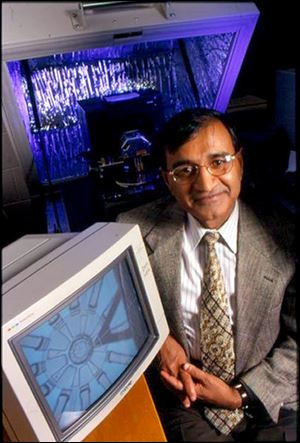
Slick discovery: Ohio State researcher finds a way to make surfaces as smooth as glass - and water-repellent, too
1/31/2005
Bharat Bhushan, professor of mechanical engineering at Ohio State University, pioneered new techniques for measuring friction in microdevices and lubricating them, which could lead to innovations like self-cleaning glass.
To be incredibly smooth, you need to be rough enough.
An Ohio State University researcher says he has a way to make materials that have the surface friction of a sports car on black ice. The materials also repel water with ease. Bharat Bhushan, a professor of mechanical engineering, says the secret is to create surfaces that are landscapes of microscopic bumps.
The technique could lead to the manufacture of things such as self-cleaning glass and friction-free parts in nanomachines.
By studying the surface of lotus leaves, which are naturally hydrophobic - or water repellent - Mr. Bhushan found clues to creating super water-repellent surfaces.
The apparently smooth leaves of these water lily relatives are actually a forest of raised bumps when viewed through an electron microscope.
"We wanted to know what nature does, and that helps guide us," Mr. Bhushan said.
The result is a patent application for a computer program that can determine what pattern of bumps will make a surface hydrophobic, Mr. Bhushan said.
"I don't know anyone who's doing a model of our type in the world," Mr. Bhushan said, although "obviously, people have thought about creating rough surfaces before" to achieve smooth results.
At its simplest, a rough surface reduces friction by limiting the amount of surface available for contact. "If I put my hands together, they are not entirely in contact. My hands are rough on a microscale,'' Mr. Bhushan said. If the contact surface is reduced, so is friction.
Water droplets that land on such a surface will roll off the rough terrain, if it's properly textured, instead of hanging around getting things wet.
The water repellent surfaces proposed by Mr. Bhushan are of a different type from what Pilkington North America uses to make its Activ Self-Cleaning Glass, said David Strickler, a research and development project manager for Pilkington in Toledo.
Pilkington's glass is coated to make it hydrophilic, or water loving. When water hits the glass, instead of beading up and rolling away, the water forms a sheet and slips away.
Still, Mr. Bhushan's work makes sense, said Mr. Strickler. "I think his ideas are sound."
But the real utility of Mr. Bhushan's bumpy surfaces will be micro and nanotechnology. Oil is no help in lubricating molecule-size devices. In 2001, Mr. Bhushan's research group developed a way to measure friction in micromachines, and he's been working to find ways to reduce that friction.
"People do it by applying various coatings and creating a hermetic seal to minimize the effect of the environment. Here is another way, an inexpensive way, to reduce that effect," he said.
"As you get into the micro and nano scale, surface interactions really dominate," said Josh Jacobs of Texas Instruments in Dallas. "The adhesion between two surfaces at micro and nanoscale has to be essentially overcome in these devices."
He called Mr. Bhushan's work "an important first step to microdevices that will function even in the presence of atmospheric water."
Contact Jenni Laidman at: jenni@theblade.com or 419-724-6507.